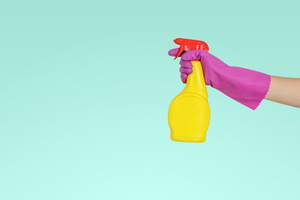The conversation about the health and wellness of the ocean tends to focus heavily on plastic pollution. After all, by 2050 the ocean is expected to contain more plastics than fish, by weight (source: World Economic Forum). As harrowing as this statistic is, it’s really just the tip of the metaphorical iceberg. In reality, the pollutants threatening our ocean and natural world extend far beyond plastic debris, and the number one culprit is chemical pollution. Between car parts, soda flavorings, and household cleaners, chemicals are a prevalent and often necessary part of our everyday lives. But when unleashed into the natural world, these chemicals can cause havoc and ecosystem disruption.
Plastic Pollution and Chemical Pollution Are Connected
- Mind you, we don’t want to understate the plastics issue (and you can read our other blog post here on the connections between plastic and climate change). In fact, the chemical pollution problem is very much connected with, and fueled by, plastic pollution. When plastic is exposed to harsh elements (such as sun or salt water) it begins to break down and leaches chemicals into our natural world. This means that when plastics enter the ocean, their physical presence is not only a threat to marine life and our natural world, but they also have this unseen malevolent impact. And in addition to their own chemical pollution, plastics can act as a sponge to external chemicals, and then spread those chemicals throughout the water as they move with the ocean currents (source: Ocean Conservancy). In 2015, an assessment was conducted to analyze the top seven plastic items collected during beach cleanups that year. According to Ocean Conservancy, these seven plastic items alone “carry with them 190 metric tons of 20 different chemical additives” (source: Ocean Conservancy).
There Are Many Forms of Chemical Pollution
- Unlike plastics, which are in most cases visible and able to be picked up, chemical pollution comes in many different forms, including heavy metals, persistent organic pollutants, pesticides, sewage, medicines, and radioactive materials (source: Back to Blue). The sheer quantity of chemicals not only multiplies and intensifies the pollution problem, it also makes it even more difficult to track and remove them from our oceans and natural world. Perhaps it is also this ubiquitous nature of chemicals that has enabled them to seep into some of the more remote areas of our natural world. Chemicals are present in the deepest parts of the ocean and in all manner of marine life (source: Back to Blue). The volume and variety of chemicals make them particularly dangerous. For instance, the nutrient runoff that contributed to dead zones in the Gulf of Mexico and the oxybenzone (sunscreen) exposure that contributed to coral bleaching both fall under the umbrella of chemical pollution.
Both Humans and Animals Are in Danger
- Aside from the desire to save nature for nature’s sake, it’s become irrefutable that we are all connected and what hurts the natural world will ultimately come back to harm us as well. The effects of chemical pollution on humans are many and varied. There are less critical issues, such as in states like California it is often unsafe to swim in the ocean after rainfall because of the significant increase in runoff and chemicals that have been caught by the falling droplets and drained into larger bodies of water. And then there are the more concerning problems, like humans ingesting these chemicals (in very concentrated amounts) through the process of bioaccumulation. These bioaccumulative chemicals also affect animals that are higher up the food chain, with the impacted species sometimes having “contamination levels in their bodies millions of times higher than the surrounding water” (source: One Ocean). In animals, these chemicals are especially harmful, and can lead to both a decrease in the ability to reproduce and an increase in offspring mortality rates (source: One Ocean).
What Now?
- The knowledge that there are multiple forms of oceanic pollution – that feel like they are multiplying – can seem really overwhelming. But rest assured that each individual has the power to mitigate the harmful effects of chemical pollution. Firstly, we can limit our consumption of plastic. As we’ve described in this post, plastics contribute to the pollution and degradation of our natural world in so many ways. All of us can help put an end to the need for single-use plastics by gearing up with a set of reusable travel utensils or switching to a zero waste safety razor. We could also participate in river or beach cleanups (depending on availability and where you live), to further remove both the chemicals leached by plastics and the chemicals plastics help transport. Another action could be to begin purchasing items that don’t use the chemicals often found in the ocean, like organic foods or potting soils (no pesticides), or reef friendly sunscreen (no oxybenzone). Lastly, we all have the opportunity to vote, and voting is immensely important because the fact remains that some politicians recognize the threat that climate change contributors like chemical pollutants pose to civilization itself, and others ignore it in order to appease their corporate donors.
